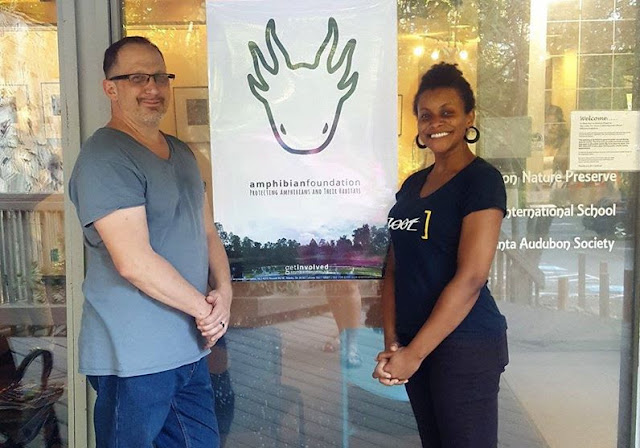Happy Birthday (to us) - The Amphibian Foundation is One!
The Amphibian Foundation is celebrating our one year anniversary this month! It’s been a whirlwind of a year, and we want to thank you for your continued support. Read below to learn about our tremendous growth and key accomplishments, achieved with your help!
 |
| Amphibian Foundation founders Mark and Crystal Mandica, standing outside the Blue Heron Nature Preserve shortly after incorporating one year ago. |
Building an Amphibious Presence in Atlanta
If you’re a regular blog guest, then you know that the Amphibian Foundation was founded in 2016 as a nonprofit dedicated to protecting endangered amphibians and their habitats. But did you know that in one year, the Amphibian Foundation:
- Created an office and labs at the Blue Heron Nature Preserve in Atlanta.
- Formed a Board of Directors with 6 members.
- Built a team of 25 staff members and dedicated volunteers.
- Trained 5 interns, and expanded into an internationally recognized internship program.
- Cared for more than 100 amphibians and reptiles, our educational ambassadors. This does not include the three species in the Captive Breeding Program. (Note: we are a licensed facility with the state and federal governments.)
With additional hands on deck, we developed and expanded the key components of the organization - leading one-of-a-kind conservation research activities, providing unique educational opportunities for all ages, and collaborating with partners to meet mutual goals. Four key achievements in the past year include:
Established a Captive Breeding Program, the core of our conservation research.
- Addressing the decline of 3 endangered species native to Georgia - frosted flatwoods salamanders, Carolina gopher frog, and the striped newt.
- Maintaining the only captive population of the frosted flatwoods salamanders, which have suffered a 90% loss in population since 2000.
- Holding 1 of 2 captive populations of the gopher frog, Georgia's rarest frog species.
- Raising the amphibians to produce offspring in captivity to release into protected habitat in the wild.
In August 2017, the Amphibian Foundation joined the Striped Newt Repatriation Project. AF’s Executive Director, Mark Mandica, with partners in the field. (photo by Greg Brashear)
|
Managed the Metro Atlanta Amphibian Monitoring Program (MAAMP).
- Coordinated 127 citizen scientists to assess the health of Atlanta’s urban amphibian communities and identify sites for restoration.
- Collected vital data on 28 frog and salamander species native to Atlanta area by surveying nearly 40 sites each month.
Expanded Critter Camp, a key educational initiative.
- Hosted 15 science-based summer camps for students to explore amphibians and reptiles in a safe, hands-on approach.
- Inspired nearly 100 campers to be mindful of amphibian conservation.
| Campers at AF’s Critter Camp meet more than 100 animals, learn biological concepts, and leave knowing how to identify a frogs by their call. |
Strengthened partnerships and enhanced reach.
- Collaborated with partners across the globe to implement lasting solutions to the global amphibian crisis.
- Led or participated in numerous presentations/workshops and increased social media following by 1,800+ followers in 6 months to raise awareness.
 |
| Crystal Mandica and WABE's Molly Samuel (and a Mossy Gecko) |
The Amphibian Foundation plays an integral role in the fight against amphibian extinction. We couldn’t do it without our partners, members, and donors - thank you for your continued support!
— Lacey Avery, Communications Lead — The Amphibian Foundation



Comments
Post a Comment